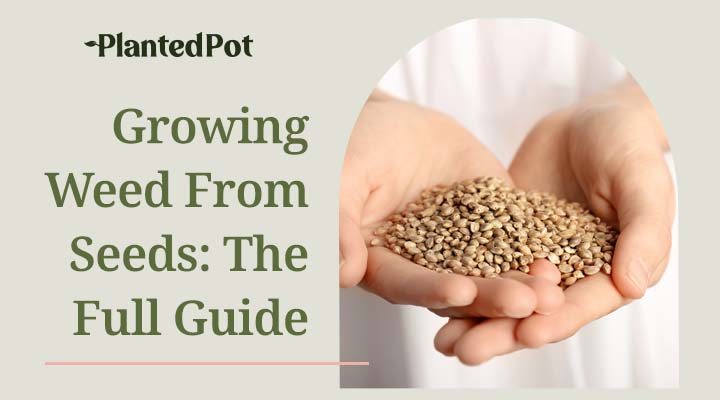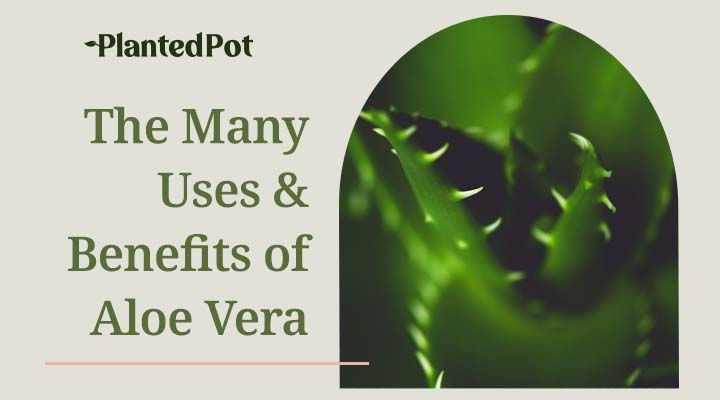
Croton Plant Care: The Ultimate Guide to Rainbow Leaves
Home / Croton Plant Care: The Ultimate Guide to Rainbow Leaves
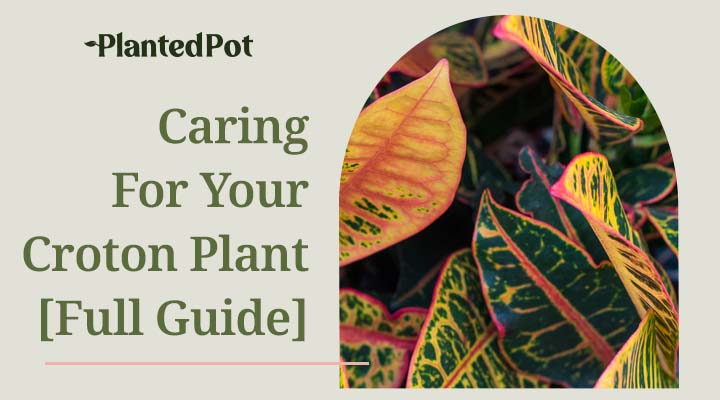
Croton Plant Care: The Ultimate Guide to Rainbow Leaves
Bold, vibrant Croton plants are the colorful perennials of plant lover’s dreams. While they don’t bloom with flowers, the Croton’s wide, glossy leaves boast rich rainbow hues throughout the year. When you give a Croton plant the right care, their mesmerizingly unique leaves add a splash of tropical warmth to any room or garden they’re placed in.
What is a Croton Plant?
Croton plants (pronounced “crow-tun”) originally hail from the regions of Southeast Asia, making it a tropical plant. There are several varieties, but one of the most common is the “garden Croton,” scientifically known as the Codiaeum variegatum. Croton plants are vibrant, resilient, and eye-catching.
The Croton plant features an array of broad, colorfully variegated leaves. Oftentimes, they’ll have a green base color that’s spotted and smeared with bright hues of orange, pink, yellow, red, purple, and even gold! Some of the coolest leaves have boldly colored veins that stand out from the green background in a naturally wondrous pattern.
Some types of Crotons can grow to nearly 10 feet tall, though most houseplant varieties cease growing at around three feet. The dynamic leaves, densely clustered at the base, fan out to create a colorful display of tropical nature. Croton plants are full, burgeoning, lively beings.
Are Croton Plants Easy to Care For?
Because of the tropical climate from which they hail, Crotons have earned a bit of a reputation for being high-maintenance. But, once this plant acclimates to a new environment, the Crotons become increasingly easy to care for. We’ll go over their basic care tips later on.
Related: PLANT CARE 101 - THE TOP 10 TIPS FOR NEW PLANT OWNERS
Can You Grow Croton Plants Indoors and Outdoors?
You can keep Croton plants both indoors and outdoors! They grow well outdoors in warm, humid climates. But once the night temperatures fall to near 50°, they will need to come indoors. Crotons can grow outdoors in Southern California, but the low humidity and occasional winter frosts can hurt them. Crotons flourish best outdoors in climates like those of Florida. Constant heat, sunlight, and above-average humidity make the best conditions for these finicky plants.
It is much easier to grow Crotons indoors, and you can do this in almost any region. Because you can control the internal temperature and provide your Croton with humidity, they tend to do quite well indoors. The biggest trick with indoor Crotons is ensuring they get adequate sunlight.
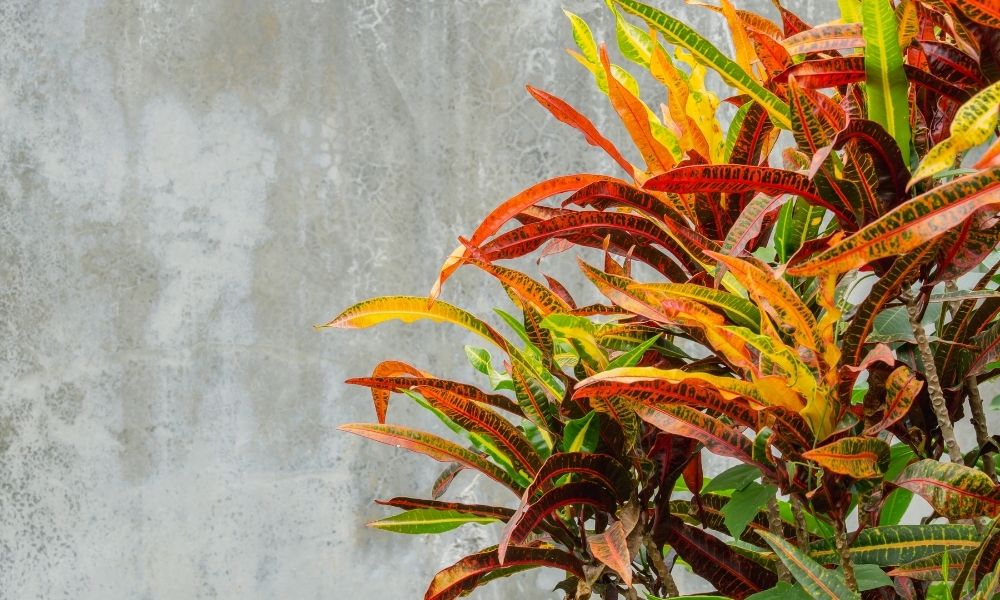
What Are the Benefits of a Croton Plant?
Crotons offer a unique way to add a colorful plant to your home without buying flowers. While many people love fresh blooms, there are several reasons why someone might not want flowers in their home (allergies, pets, dropping petals, etc.). Crotons are a colorful, flowerless solution.
Plus, Crotons retain their vibrant colors throughout the year. Most flowering plants only bloom for a season, and it can be tricky to get them to flower again the next year. With Crotons, all you need to do is make sure they’re getting plenty of sunlight, and they’ll remain multicolored all year long.
Croton plants are more than a pretty face, though. They’re also known for their air-purifying abilities! Adding a Croton to your home can help remove harmful toxins from the air. Snake plants and Jade plants are also air-purifying, and all three look lovely when you put them together.
Croton Plant Care Tips
Croton plant care is pretty easy once you figure out the basics. When properly cared for, Crotons can live very long lives — some have been known to survive for 14 to 16 years! Let’s go over the most important Croton plant care tips so you can become a professional Croton plant parent.
Choosing the Right Soil
Choosing the right soil is vital for each unique plant variety, and the Croton is no exception. Crotons need well-draining soil that will let excess water escape yet retain enough to keep them hydrated.
We recommend adding a layer of pea gravel to the bottom of your Croton’s pot to encourage drainage. On the top 1/2 inch of pea gravel, fill the rest of the pot with a well-draining, indoor potting soil. Organic compost, peat moss, and occasional coffee grounds are also beneficial to Croton growth.
Finding the Right Pot
When you’re shopping for a pot, choose one that is about 1/3 larger than your Croton plant’s root ball. For example, if your root ball is about three inches wide, find a pot that is four inches wide. This gives it room to grow and will also prevent it from falling over as it matures and becomes top-heavy.
If you’re going to repot your Croton, only move up one or two pot sizes at a time. You’ll also want to look for a porous pot material, such as terracotta, that dries quickly.
Whichever pot you choose, just be sure that it has adequate drainage holes at the bottom. If you’re going to keep your Croton indoors, place a drainage tray underneath to catch excess water.
Watering Your Croton Plant
Crotons don’t need as much water as many other houseplants, but they do need their soil to remain moist. In general, wait until the top one to two inches has dried out before giving your Croton a generous drink. When water begins to drip from the bottom, you’ll know it’s properly hydrated.
Feeding Your Croton Plant
To give your Croton a nutritional boost, place slow-release fertilizer pellets on the soil at three specific times of the year: early spring, early summer, and mid to late summer. If you think your Croton needs some extra fertilizer, you can add a little bit in at other times – just don’t overdo it.
Fall and winter is this plant’s dormant season, which means it isn’t growing. Your Croton does not require fertilizer during these months. The early spring fertilizer will be more than enough to get your plant up and growing once again.
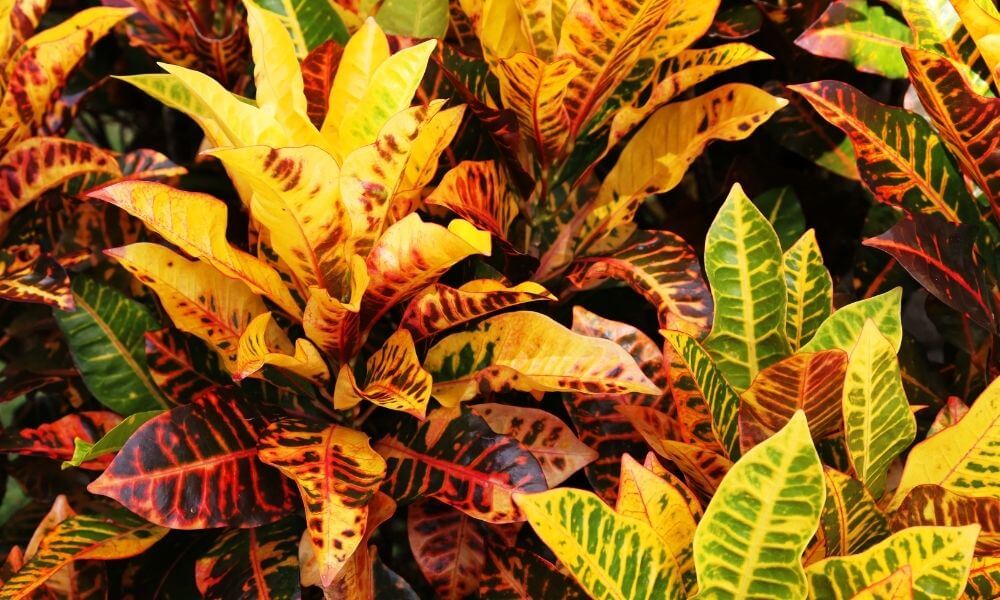
Croton Plant Placement and Lighting
Placement is one of the most important aspects of caring for the Codiaeum variegatum. Croton plants need an abundance of bright, direct sunlight to thrive. The more direct sunlight they absorb, the more vibrant their colors will be.
When choosing a spot for your Croton, look for a south, west, or southwest facing window. These typically let in a good amount of natural, direct light. If possible, try to make sure your Croton gets between four and six hours of direct sunlight each day.
Humidity and Temperature
Croton plants enjoy warm temperatures and slightly above average humidity that mimics their natural tropical habitat. Temperatures between 60° and 80° and 50 to 60% humidity are ideal conditions for Crotons. Do your best to keep them away from drafts and air conditioners.
Pruning a Croton Plant
You can prune your Croton to keep it short and wide, but it isn’t necessary to do this often. If you notice sparse or dying leaves, trimming off those areas will help encourage fresh, healthy growth. The only times to avoid pruning your Croton are before a cold snap and during the growing season.
Common Issues Found in Croton Plants
When caring for your Croton plant, it’s good to keep in mind that some bugs love to munch on the colorful leaves. Spider Mites are a frequent houseplant pest that tends to pop up when the humidity is too low. They’re tiny and hard to see, but if you see webbing around your plant’s branch intersections, you can be sure Spider Mites are the culprit.
Mealybugs and caterpillars can also be problems for Crotons, but they aren’t as common as Spider Mites. Regardless of what kind of pests you find, using insecticidal soap is an awesome, certified-organic way to get rid of them. You can also take your Croton outside to spray it with a hose.
Besides pests, be careful of root rot. This can happen if you overwater your plant. Be cautious of drenching your Croton in too much water, and check for root rot each time you repot. If the roots are turning dark brown/black and are slick with fungi, your Croton likely has a case of root rot.
If the root rot isn’t too bad yet, you may be able to save your Croton plant. Brush all excess dirt away and thoroughly rinse the roots under room temperature running water. Then, clip the damaged roots, leaving behind the firm, white roots that appear healthy.
How Do I Know if My Croton Plant is Dying?
If your Croton plant’s leaves are excessively browning and thinning, or if it has a bad case of root rot, it may be dying. However, Crotons are extremely resilient plants and can often be brought back from the brink of death, and there’s one tried and true way to know if your Croton has a chance.
If you think your Croton is dying, scrape the stem with your fingernail or a small knife (not too deep!). If there’s green beneath the surface, your Croton is still alive, and it may be possible to save them. But if you only see brown under the surface, it may sadly be time to say goodbye to your Croton.
Are Croton Plant Plants Poisonous?
Yes, Croton plant leaves can be toxic to animals and humans when digested in large quantities. They do NOT release toxins into the air. Remember, Crotons are actually good at removing toxins from the air.
If you have curious pets or young kids, choose a spot that’s out of their reach. However, if you’re concerned that your kids will get to the Croton anyway, you may not want to keep one of these plants in your home until the kids get older.
Final Thoughts
Now that you’re armed with these care tips, your Croton plant will thrive with abundant, beautiful colors! When you add a Croton to your garden or windowsill, you bring some tropical color into your home. There’s a reason that fancy resorts, restaurants, and airports in tropical regions fill their landscape with Crotons – their variegated, perennial rainbow beauty is unmatched.


